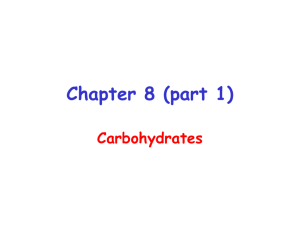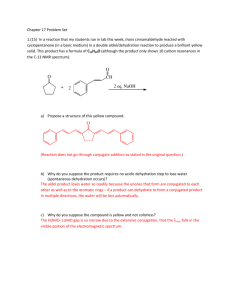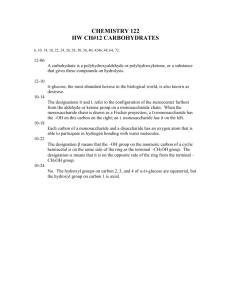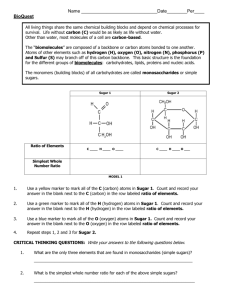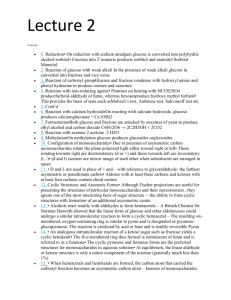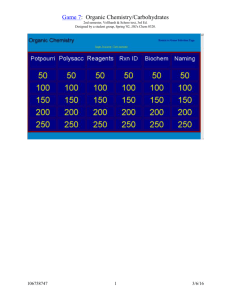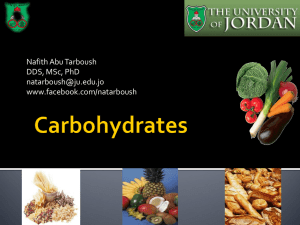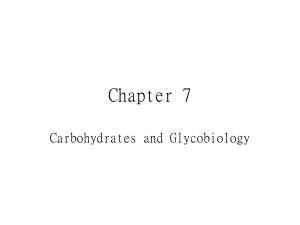1152 chapter 18 post chemistry carbs
advertisement
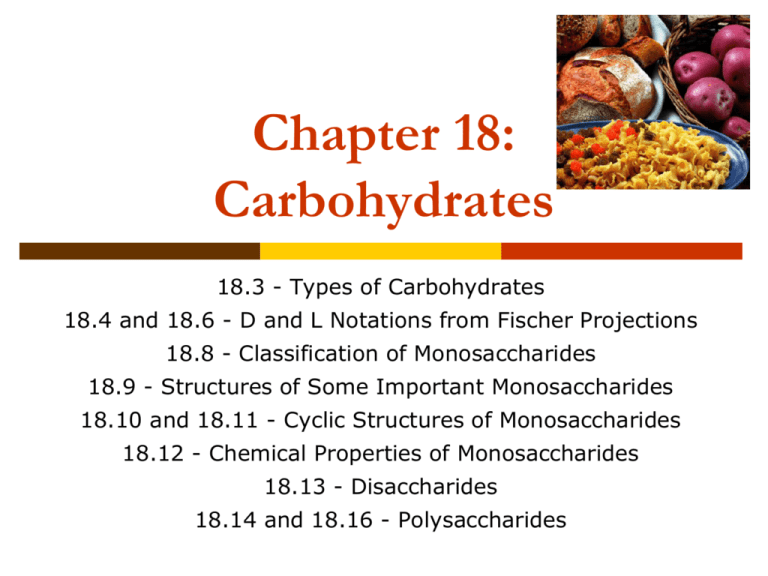
Chapter 18: Carbohydrates 18.3 - Types of Carbohydrates 18.4 and 18.6 - D and L Notations from Fischer Projections 18.8 - Classification of Monosaccharides 18.9 - Structures of Some Important Monosaccharides 18.10 and 18.11 - Cyclic Structures of Monosaccharides 18.12 - Chemical Properties of Monosaccharides 18.13 - Disaccharides 18.14 and 18.16 - Polysaccharides Carbohydrates Most abundant organic compounds in nature Produced by photosynthesis in plants Composed of the elements C, H and O Also called saccharides, which means “sugars” A major source of energy from our diet A source of C for synthesis of other biomolecules Can be linked to cell membranes or proteins Types of Carbohydrates Monosaccharides are the simplest carbohydrates Empirical formula = CH2O Oligosaccharides contain a few monosaccharides (2-10) Disaccharides consist of two monosaccharides Polysaccharides contain many monosaccharides Chiral Molecules Chiral molecules Achiral molecules Have “handedness” Nonsuperimposable on mirror images Ex: hand, shoe Do not have handedness Ex: glass, spoon Chiral molecules contain carbons with 4 different groups Called chiral carbons or chiral center CHO Br C CH3 OH Fischer Projections Used to represent carbohydrates Places the most oxidized group at the top All chiral carbons are represented as intersection of lines C is not shown Implied 3D arrangement of atoms Horizontal lines for bonds that come forward Vertical lines for bonds that go back D and L Notations By convention, the letter L is assigned to the structure with the —OH on the left The letter D is assigned to the structure with —OH on the right D and L Monosaccharides The —OH on the chiral atom farthest from the carbonyl group is used to assign the D or L configuration O C CHO H H OH H OH HO H OH CH 2OH D D-Ribose O H OH C OH HO H H H OH H OH H OH H OH HO CH2OH D D-Glucose H CH2OH LL-Galactose Learning Check Indicate whether each is the D or L isomer: CH2OH CHO HO CHO H HO H HO H CH2OH H HO OH H CH2OH O HO H H OH H OH CH2OH Ribose Threose Fructose Classification of Monosaccharides Monosaccharide = unbranched chain of 3-8 C atoms; one is carbonyl, others attached to -OH Aldose monosaccharide with an aldehyde group (1st carbon) Ketose monosaccharide with a ketone group (2nd carbon) CH2OH O CHO CHO HO H CH2OH Aldose HO H H HO H OH H OH CH2OH H OH Aldose CH2OH OH Ketose Monosaccharides Monosaccharides are also classified according to the number of carbon atoms A triose has three carbons; a tetrose has four carbons; a pentose has five carbons; and a hexose has six carbons. CH2OH O CHO HO CHO HO H H CH2OH triose aldotriose H HO H OH H OH CH2OH H OH tetrose aldotetrose CH2OH OH hexose ketohexose Learning Check Identify each as tetrose, pentose or hexose, and as aldose or ketose: CH2OH CHO O HO H HO HO H H OH HO H H OH CH2OH A H CH2OH B D-Glucose Most common hexose Found in fruits, corn syrup, and honey An aldohexose with the formula C6H12O6 Known as blood sugar in the body Building block for many disaccharides and polysaccharides D-Galactose Aldohexose Differ from D-glucose at C4 C1 is at the top Not found in the free form in nature Obtained from lactose, a disaccharide (milk products) Important in cellular membranes in CNS (brain sugar) CHO H C OH HO C H HO C H H C OH CH2OH D-Galactose D-Fructose Ketohexose C6H12O6 Differ from glucose at C1 and C2 (location of carbonyl) The sweetest carbohydrate (2x sucrose) CH2OH C O HO C H Found in fruit juices and honey Formed from hydrolysis of sucrose H C OH Converts to glucose in the body H C OH CH2OH D-Fructose Learning Check Draw the structure of D-fructose: Hemiacetal Review What is a hemiacetal? How is a hemiacetal formed? OH O + H CH3 C + H CH3 CH3OH C H OCH3 What if the alcohol and carbonyl are attached? H O H H H HOCH2 H HO H O O O = C H O C HOCH2 CH2OH O H+ C = C HO H O O C H+ O O C H H Hexose hemiacetals Favor formation of 5- or 6-membered rings Hydroxyl group on C5 reacts with the aldehyde or ketone The Haworth structure can be written from the Fischer projection The cyclic structure of a D-isomer has the last CH2OH group located above the ring The –OH group on the left (C3) is drawn up The –OH groups on the right (C2, C4) are drawn down and Anomers for D-Glucose Anomers are isomers which differ in placement of hydroxyl on C1 The –OH is drawn down for the -anomer, and up for the -anomer CH2OH O O OH OH OH OH OH OH -D-Glucose CH2OH OH OH -D-Glucose Mashed potatoes or mashed paper? Mutarotation In solution, -D-glucose is in equilibrium with β-D-glucose Mutarotation involves the conversion of the cyclic anomers into the open chain At any time, there is only a small amount of open chain aldehyde Cyclic Structure of Fructose As a ketohexose, fructose forms a cyclic structure when the —OH on C5 reacts with the ketone on C2 Result is 5-atom ring Anomeric carbon is C2 CH2OH C O HO C H CH2OH O H C OH H C OH CH2OH D-Fructose CH2OH CH2OH O OH -D-Fructose OH CH2OH OH OH OH OH -D-Fructose Learning Check Write the cyclic form of -D-galactose: H CH2OH O C H C OH HO C H o OH OH HO C H OH H C OH CH2OH OH -D-galactose Review: Reactions of aldehydes 1. Oxidation to form carboxylic acids 2. Reduction to form alcohols 3. Formation of hemiacetal 4. Hemiacetal + alcohol → acetal Now we’ll see all of these with monosaccharides… 1. Oxidation of Monosaccharides Monosaccharides are reducing sugars if their carbonyl groups oxidize to give carboxylic acids. In the Benedict’s text, D-glucose is oxidized to D-gluconic acid. Glucose is a reducing sugar. O O H C C H C OH HO C H H C OH OH H C OH + Cu2+ HO C H H C OH H C OH H C OH CH2OH CH2OH D-Glucose D-Gluconic acid + Cu2O(s) 2. Reduction of Monosaccharides The reduction of the carbonyl group produces sugar alcohols, or alditols D-Glucose is reduced to Dglucitol (also called sorbitol) 3. Monosaccharides + alcohol Formation of hemiacetal (cyclic structures) 4. Monosaccharide hemiacetals + alcohol When a cyclic monosaccharide reacts with an alcohol: A glycoside is produced (acetal) The bond is a glycosidic bond or glycosidic linkage CH2OH CH2OH O O OH + HOCH3 OH glycosidic bond O CH3 OH + H2O OH OH OH OH -D-Glucose Methanol Methyl--D-glucoside Learning Check Write the products of the oxidation and reduction of D-mannose. O C H HO H HO H H OH H OH CH2OH D-Mannose Disaccharides A disaccharide consists of two monosaccharides Disaccharide Monosaccharides H+ Maltose + H2O Glucose + Glucose Lactose + H2O Glucose + Galactose Sucrose + H2O Glucose + Fructose Maltose Malt sugar A disaccharide in which two D-glucose molecules are joined by an -1,4glycosidic bond Obtained from starch Used in cereals, candies, and brewing A reducing sugar (has a hemiacetal) Lactose Milk sugar Composed of galactose and glucose linked by a -1,4-glycosidic bond Lactose intolerance A reducing sugar Sucrose Table sugar Is composed of glucose and fructose molecules joined by ,-1,2-glycosidic bond Has no isomers because mutarotation is blocked Not a reducing sugar (no hemiacetal) Sweetness of Sweeteners Sugars and artificial sweeteners differ in sweetness Each sweetener is compared to sucrose (table sugar), which is assigned a value of 100 Learning Check Identify the monosaccharides in lactose, maltose, and sucrose as glucose, fructose, and/or galactose: A. Lactose B. Maltose C. Sucrose Polysaccharides Polysaccharides are polymers of monosaccharides “Complex” carbohydrates Important polysaccharides of D-glucose are: Starch (Amylose and Amylopectin) Glycogen Cellulose Starch and Glycogen Storage polysaccharides Form monosaccharides used for energy Starch Plants Amylose is a continuous chain of glucose molecules linked by -1,4 glycosidic bonds. Amylopectin is a branched chain of glucose molecules linked by -1,4- and -1,6-glycosidic bonds. Glycogen Humans, animals Similar to amylopectin, but more highly branched. Structures of Amylose and Amylopectin Cellulose Structural polysaccharide Plant cell walls (cellulose) and animal exoskeletons (chitin) Cellulose is a polymer of glucose molecules linked by -1,4glycosidic bonds Enzymes in saliva can hydrolyze -1,4-glycosidic bonds in starch, but not -1,4-glycosidic bonds in cellulose Learning Check Identify the types of glycosidic bonds in: 1) Amylose 2) Glycogen 3) Cellulose End of Chapter 18!
